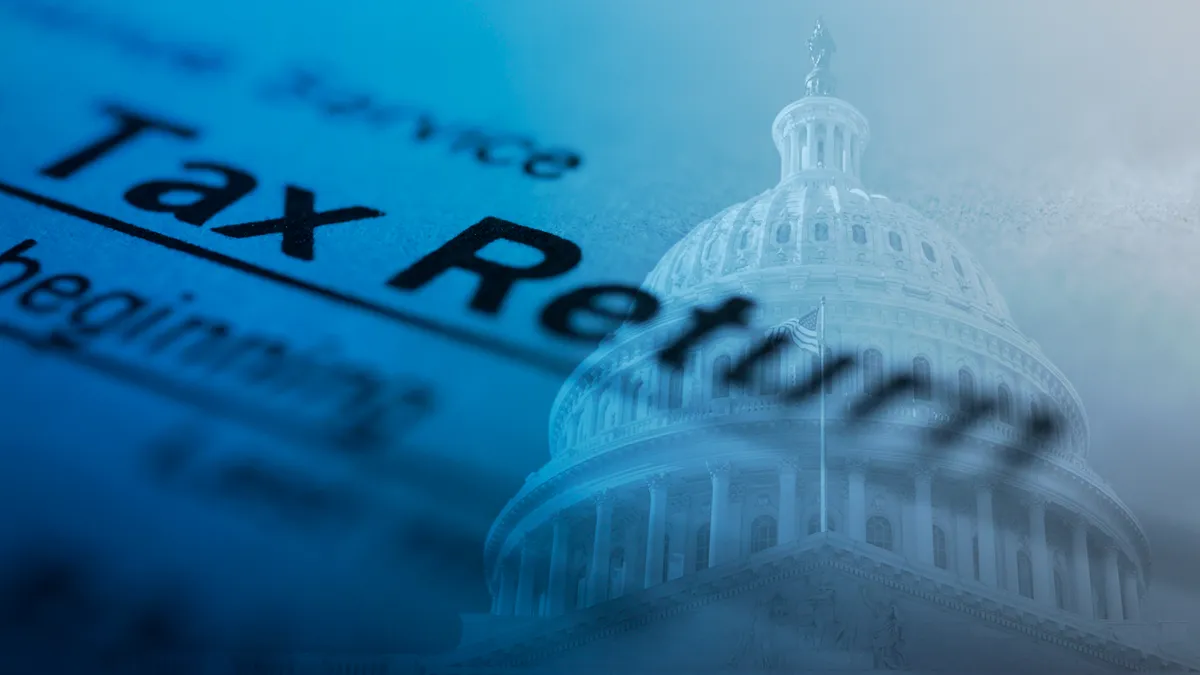Companies should brace for change.
The 30-plus-year drought since the last tax code overhaul may be finally over as Congress sets out to vote on and place a now-finalized tax bill on President Donald Trump's desk.
The bill slashes the corporate tax rate from 35% to 21%, and also includes massive changes to how income earned or kept offshore is treated. Every industry could see effects — including higher education. Here's a 60-second overview of what the bill could change, and where industry associations stand on it:
EDUCATION: HIGHER ED
IMPACT: Higher ed leaders are watching closely to see how impacts to itemized deductions will impact charitable giving, and many are concerned a number of changes would decrease state appropriations while increasing the tax burden for the industry’s largest institutions.
POSITION: Because of the broad differences in the sizes, budgets and missions of higher education, there are differing positions on the legislation. However, many of the largest and wealthiest institutions may see a greater impact to their bottom lines via endowment taxes and new taxes on the top-paid officials, and smaller institutions are keeping a close eye on how charitable giving changes will impact day-to-day operations.
ANALYSIS:
Some of the biggest concerns in the tax bill for higher education leaders are the proposed endowment tax for private institutions; the changes to individual deductions, including changes to the way charitable giving can be itemized and the ability to deduct state and local income taxes; and the elimination of private activity bonds that can impact college and university foundations that are involved in real estate. The bill also proposes a 21% tax on the top-five paid individuals with salaries over $1 million at nonprofit organizations, which puts institutions on the hook for paying a tax on the salaries of the president and men’s basketball and football coaches.
The inability to deduct state and local income taxes still worries many higher ed administrators that there will be pressure on states and localities not to raise taxes, which means that though some individuals may see an increase in net earnings, there will be increasingly tough decisions about discretionary funding in state houses — and further cuts to higher ed at the state level.
And though individuals will still be able to deduct charitable gifts, the required threshold for itemization would mean an estimated loss of $12 billion to $20 billion per year for the industry starting in 2018. And the elimination of the 80% deduction for seat licenses at college sporting events may mean athletics departments lose a major incentive for potential program donors, as well, which could shift some of the athletics budget burden back to the institution.
While tuition waivers are saved from taxable income and the committee agreed to preserve the ability to deduct student loan interest, there are still a number of provisions that will impact institutions if this bill is passed.
Autumn Arnett / Education Dive
EDUCATION: K-12
IMPACT: Tax reform could impact school funding, 529 plans, teacher deductions.
POSITION: For public schools, the proposal presents yet another threat to already-stretched funding, though teachers will retain an annual deduction for supplies.
ANALYSIS: Under current laws, taxpayers can deduct what they pay in state and local taxes, a provision that naturally benefits wealthier Americans who pay more. The updated tax bill would allow single and married taxpayers to deduct up to $10,000 in state and local taxes—property, sales or income. The earlier proposal would have allowed filers to deduct all state and local taxes.
An earlier proposal would have eliminated that deduction, which education analysts suggested could lead to increases in other taxes and likely impact state and local funding for education. The National Education Association had predict a cost to public schools of $370 million over 10 years, leading to job cuts for teachers. The latest proposal would cause less of a hit, but could still impact state spending.
The final bill also doubles the Child Tax Credit from $1,000 to $2,000, and extends the deduction for families earning up to $400,000 per year. Up to $1,400 of the credit is also refundable, which puts money into the hands of low-income families who would not otherwise earn enough to actually owe federal taxes.
Additionally, families putting money away in 529 plans for their children’s college education could withdraw up to $10,000 without a penalty in order to pay for private school or even home-schooling expenses. Opponents say the provision doesn’t help most families and can hurt savings for college in long run.
Finally, the bill will leave in place a teacher deduction of $250 annually for money spent on school supplies out of their own pockets. Earlier proposals had suggested cutting the deduction altogether or doubling it to $500. Educators reportedly spend $1.6 billion of their own money on school supplies each year — an amount that comes down to an average of about $485 per individual teacher.
Roger Riddell, Linda Jacobson / Education Dive
HUMAN RESOURCES
IMPACT: Tax reform is expected to impact several areas of interest to HR: paid leave, fringe benefits, automation and offshoring.
POSITION: The tax proposal could, on balance, be good for companies and in turn good for HR professionals. The industry has not taken a specific stance on the issue to date.
ANALYSIS: Tax reform is expected to impact several areas of interest to HR including some core issues such as paid leave, fringe benefits, automation and offshoring.
One proposal would give employers a tax credit equal to 25% of an employee's salary if it paid them during FMLA leave. There are several proposals to scrap deductions for benefits employers often are involved in, like transportation and relocation expenses.
Some thought the bill might create new tax incentives to encourage employers to create jobs. (That's what the Trump administration promised, after all.) Instead, it proposes to allow employers to write off the full value of machines right away, perhaps encouraging automation without an accompanying incentive for hiring humans.
The bill proposes to exempt some income from U.S. companies with operations outside the country. This encourages business to send work overseas, some experts have said.
HR will probably like the paid leave proposal, as it gets at an existing problem without a mandate. Instead, it's an incentive to do something many are already doing anyway. On the flip side, the fringe benefit exclusions do the opposite, creating a disincentive for employers to offer those benefits.
The automation and offshoring items are, on their face, good news for companies. Some, however, say they're not as useful without an incentive to hire people, too. After all, machines can't be upskilled when needs shift.
Kate Tornone / HR Dive
CONSTRUCTION
IMPACT: The public construction sector will benefit from the uninterrupted flow of private-activity bond financing, and both the contractors who are structured as pass-through entities and C Corporations will see significant tax relief.
POSITION: The retention of tax-free status for PABs, as well as favorable treatment of energy-related exploration and tax credits have some segments of the industry breathing a sigh of relief, but potential PAB use limits and the locking out of design professionals from being able to take advantage of the new, lower pass-through tax rate could result in some pushback.
ANALYSIS: The House GOP tax bill, passed early in November, took aim at PABs – a financing scheme that allows private entities developing public projects to borrow at the same tax-free rate as government agencies do – and eliminated them altogether. The Senate's version restored PABs, possibly driven by the expectation that they will play a big role in financing the president's $1 trillion infrastructure plan, but both chambers call for a termination of another popular finding vehicle, tax-exempt stadium bonds. Some states and municipalities rely on tax-free bonds for their contributions to the new construction and renovation of sports venues – often a condition of being able to snag a professional team – but, according to the Brookings Institution, the federal government loses out to the tunes of billions when projects that are financed this way.
The latest version of the reconciled bill also sets a new 21% tax rate for corporations, a break for everyone except those low-earners that currently pay 15%. But many construction companies are pass-through entities, a structure that allows owners to include business profits on their personal tax returns. The new tax reform measure gives those individuals a 20% break on that income, a bigger break that the House bill's rate of 25%. However, some in the industry were frustrated by a provision that professional service and consulting firms like architects and engineers to take that deduction.
The energy sector got better news when it was revealed that the Senate bill would reinstate the wind sector's production tax credit that the House bill eliminated. While the industry awaits the final version of the joint bill, word is that that credit, as well as one for the purchase of electric vehicles, will stay put. The measure also green-lights exploration in Alaska's Arctic National Wildlife Refuge.
Kim Slowey / Construction Dive
TECHNOLOGY
IMPACT: Tech companies with large overseas cash holdings will benefit from cuts to corporate tax rates, but SMBs and companies with larger domestic holdings may not be as lucky.
POSITION: Big tech lobbied hard for a cut to the corporate tax rate, but the loss of R&D tax breaks and new income tax applications on grad students may undercut the win.
ANALYSIS: The corporate tax rate currently sits at 35%, but the tech sector on average pays much lower than that. For example, the average tax rate is about 16% for computer services companies and about 25% for internet software companies, according to Aswath Damodaran, professor at the Stern School of Business professor. Moving the overall rate down to 21% may not benefit tech as much as other sectors since the industry already has lower rates.
The lowered, one-time repatriation tax, however, will have a greater effect. Tech tops the list of U.S. companies with the largest overseas cash holdings. More than $564 billion is held abroad between Apple, Microsoft, Cisco, Alphabet and Oracle — $246 billion of which belongs to Apple alone.
The tax levied on overseas cash will drop from the current 35% corporate rate to 15.5% under tax reform. Less liquid assets will be taxed at 8%. For companies without large overseas cash holdings, the benefits are less substantial.
Alex Hickey / CIO Dive




















